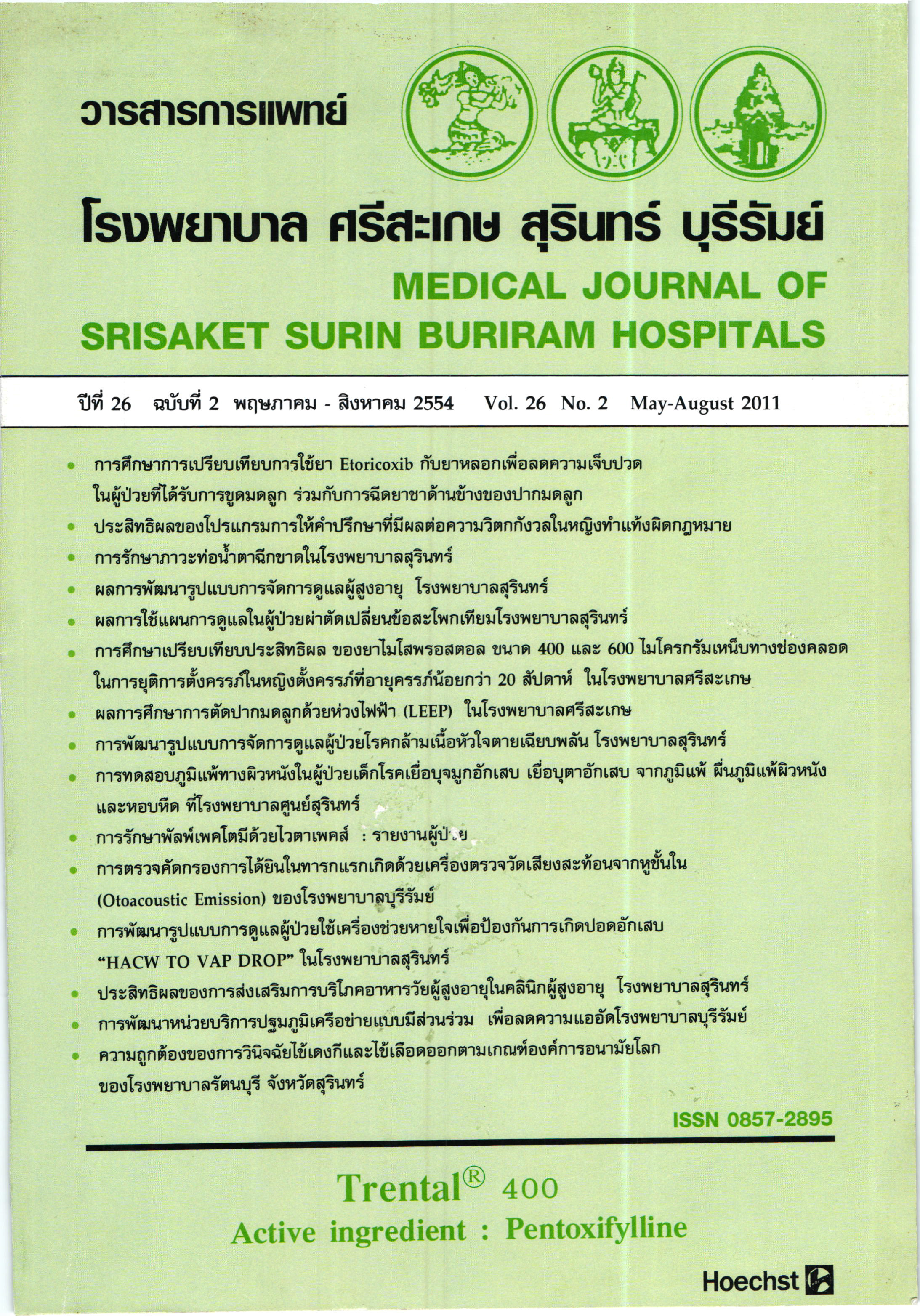การรักษาภาวะท่อน้ำตาฉีกขาดในโรงพยาบาลสุรินทร์
Main Article Content
บทคัดย่อ
หลักการและเหตุผล: ภาวะท่อนํ้าตาฉีกขาดเป็นปัญหาที่พบได้บ่อยในการบาดเจ็บบริเวณใบหน้าและเปลือกตา (maxillofacial and eyelid trauma) และจำเป็นต้องได้รับการรักษาที่เหมาะสมเพื่อ ป้องกันการเกิดนํ้าตาไหลเรื้อรัง และการระคายเคืองตาในภายหลัง การรักษาภาวะท่อนํ้าตา ฉีกขาดมีเทคนิคและอุปกรณ์ที่ใข้ในการผ่าตัดที่แตกต่างกัน
วัตถุประสงค์: เพื่อศึกษาผลการรักษาภาวะท่อนํ้าตาฉีกขาดในโรงพยาบาลสุรินทร์
รูปแบบการวิจัย: การศึกษาเชิงพรรณนาแบบย้อนหลัง
วิธีการศึกษา: ทบทวนเวชระเบียนผู้ป่วยที่มีท่อนํ้าตาฉีกขาดที่เข้ารับการรักษาที่โรงพยาบาลสุรินทร์ ตั้งแต่ วันที่ 1 มกราคม พ.ศ.2551 ถึงวันที่ 31 ธันวาคม พ.ศ.2553 โดยเก็บข้อมูลเพศ อายุ สาเหตุ และปัจจัยร่วมที่ทำให้เกิดการบาดเจ็บ ระยะเวลาก่อนการผ่าตัด เทคนิคการผ่าตัดระยะเวลาที่ใส่ stent ผลการรักษาและภาวะแทรกซ้อน
ผลการศึกษา: ผู้ป่วยทั้งหมด 95 ราย เป็นผู้ขาย 80 ราย (ร้อยละ 84.21) อายุเฉลี่ย 42±21.1 ปี (1-94 ปี) โดยมีสาเหตุของการฉีกขาดของท่อนํ้าตาส่วนใหญ่จากอุบัติเหตุรถจักรยานยนต์ 54 ราย (ร้อยละ 56.84) ผู้ป่วยทุกรายได้รับการผ่าตัดท่อนํ้าตาฉีกขาดโดยใช้ pigtail probe และใช้ nylon 3-0 เป็น stent การตรวจติดตามให้ผลการรักษาที่ดีคือ พบอาการนํ้าตาไหลเพียง 5 ราย และเปลือกตาดึงรั้งออกนอก 1 ราย
สรุป: การรักษาภาวะท่อนํ้าตาฉีกขาดโดยใช้ pigtail probe และ nylon 3-0 เป็น stent ให้ผลการรักษาที่ดี
Article Details
เอกสารอ้างอิง
Marshak H, Dresner SC. Lacrimal trauma. In: Cohen AJ, Mercandetti M, Brazzo BG, editors. The lacrimal system ; 2006 : p119-26.
Jordan DR, Ziai S, Gilberg SM. Pathogenesis of canalicular lacerations. Ophthal Plast Reconstr Surg 2008;24:394-8.
Nerad JA. Oculoplastic surgery the requisites in ophthalmology 2001. p312-347.
Ho T, Lee V. National survey on the management of lacrimal canalicular injury in the United Kingdom. Clin Experiment Ophthalmol 2006;34:39-43.
MacGillivray RF, Stevens MR. Primary surgical repair of traumatic lacerations of the lacrimal canaliculi. Oral Surg Oral Med Oral Pathol Oral Radiol Endod 1996;81:157-63.
Smit TJ, Mourits MP. Monocanalicular lesions.To reconstruct or Not. Ophtha- mology 1999;106:1310-12.
Forbes BJ, Katowitz WR, Binenbaum G. Pediatric canalicular tear repairs - revisiting the pigtail probe. J AAPOS 2008; 12(5):518-20.
Liang T, Zhao GQ, Li YL, Yang SS, Zhang LY, Wu Y. Efficiency and therapeutic effect of modified pigtail probe in anastomosing lacerated lacrimal canaliculus. Chin J Traumatol 2009;12(2):87-91.
Fayet B, Ruban JM. Monocanalicular lacrimal pathway intubation with a stable punctal attachment.In: Guthoff R, Katoeitz JA, editors. Essential in ophthalmology oculoplastic and orbit ;2006: p83-8.
Naik MN, Kelapure A, Rath S, Flonavar SG. Management of canalicular lacerations: Epidemiological aspects and experience with Mini-Monoka monocanalicular stent. Am J Ophthalmol 2008;145:375-80.
Della Rocca DA, Ahmad S, Preechawi P, Schaefer SD. Nasolacrimal System Injuries. In: Weber RK, Keeri R, Schaefer SD, Della Rocca RC ; editors. Atlas of lacrimal surgery; 2007:p91-103.
Wu S, Ma L, Chen RJ, Tsai Y, Chu Y. Analysis of bicanalicular nasal intubation in the repair of canalicular lacerations. Jap J Ophthalmol 2010;54:24-31.
Xiao-jing P, Mao A, Gui-qui Z, Xu-xia M, Shan-Shan Y. Clinical effects of three types of silicone intubations in repairing lacerations of canaliculus. Chin J Trau-matol 2009;12(3)173-6.
วีระศักดิ์ อนุตรอังกูร. ผลการผ่าตัดรักษาท่อน้ำตาฉีกขาดในโรงพยาบาลขอนแก่น. ขอนแก่นเวชสาร 2551;32:139-46.
Kriangsak Sirirak. A simple lacrimal drainage repair by three - stitch technique without stent in 28 patients at Prapokklao Hospital. Siriraj Med J 2009;61:139-42.
Landy JS, Slonim CB, Older JJ. Surgery of the punctum and canaliculus. In: Cohen AJ, Mercandetti M, Brazzo BG, editors. The lacrimal system ; 2006: p110-8.
Orhan M, Govsa F, Saylam C. Anatomical details used in the surgical reconstruction of the lacrimal canaliculus: cadaveric study. Surg Radiol Anat 2009;31:745-53.


